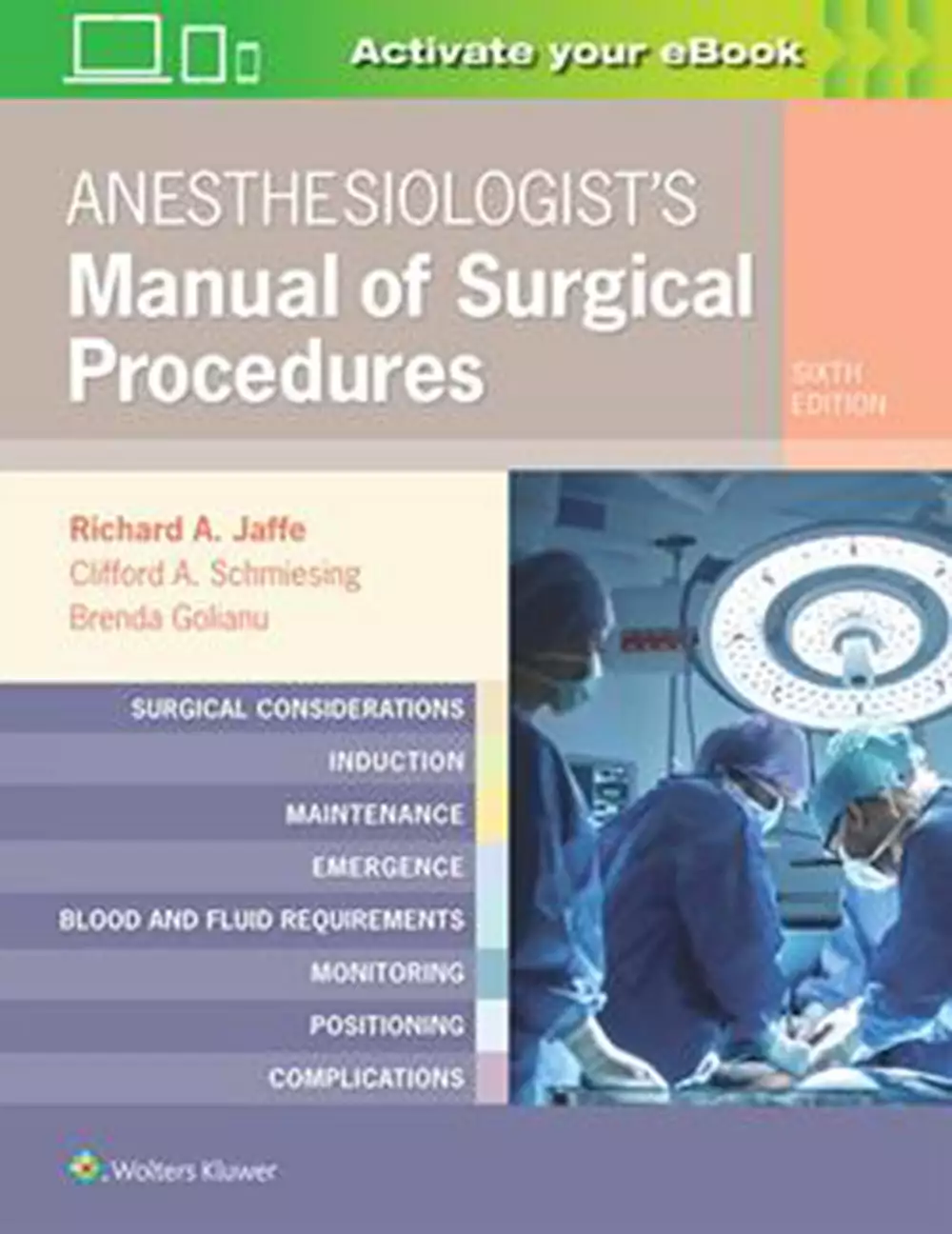Lower leg anatomy的問題,透過圖書和論文來找解法和答案更準確安心。 我們找到下列訂位、菜單、價格優惠和問答集
Lower leg anatomy的問題,我們搜遍了碩博士論文和台灣出版的書籍,推薦RichardA.Jaffe,CliffordASchmiesing,BrendaGolianu寫的 Anesthesiologist’s Manual of Surgical Procedures 和Volkmar, Michael的 Strong Legs: The All-in-one Program for Shaping Your Lower Body都 可以從中找到所需的評價。
這兩本書分別來自九州 和所出版 。
國立臺灣體育運動大學 運動健康科學學系碩士班 陳淑雅、唐誌陽所指導 周昀翰的 承重下腓腸肌肌肉狀態、足部結構與足底壓力之關係研究 (2021),提出Lower leg anatomy關鍵因素是什麼,來自於腓腸肌肌肉、足部結構、足底壓力。
而第二篇論文國立臺灣大學 物理治療學研究所 林居正所指導 賴星霓的 探討橫膈膜及呼吸對肩膀運動學和周邊肌肉活性的影響 (2021),提出因為有 橫膈膜、呼吸、肩胛骨運動學、肌電圖、核心穩定、超音波影像的重點而找出了 Lower leg anatomy的解答。
Anesthesiologist’s Manual of Surgical Procedures

為了解決Lower leg anatomy 的問題,作者RichardA.Jaffe,CliffordASchmiesing,BrendaGolianu 這樣論述:
Covering both surgical and anesthetic considerations, Anesthesiologist’s Manual of Surgical Procedures, Sixth Edition, is an essential resource for formulation of an anesthetic plan and perioperative management of patients. All chapters are written by both surgeons and anesthesiologists,
giving you a detailed, real-world perspective on the many variables that accompany today’s surgical procedures. •Presents preoperative, intraoperative, and postoperative anesthetic considerations in a clear, templated format, summarizing all courses of action in easy-to-read tables. •Describe
s what the surgeon will likely be doing, variants of the procedure or approaches, patient population characteristics, and details of the procedure including positioning, length of procedure, postop care, and more. •Features a full-color design to enhance readability of the tables and clarity of t
he illustrations. •Updates to this edition include a new, heavily illustrated chapter overviewing regional blocks and new appendices covering individual components of enhanced recovery (ERAS) protocols and intraoperative use of transnasal humidified rapid-insufflation ventilatory exchange (THRIVE
); as well as new, rapidly accessible tables and figures set on the inside back cover reviewing useful, but easily forgotten facts and dermatomes. •An ideal reference for anesthesiologists, anesthesia residents, and CRNAs. Enrich Your eBook Reading Experience •Read directly on your preferred
device(s), such as computer, tablet, or smartphone. •Easily convert to audiobook, powering your content with natural language text-to-speech.
承重下腓腸肌肌肉狀態、足部結構與足底壓力之關係研究
為了解決Lower leg anatomy 的問題,作者周昀翰 這樣論述:
背景與動機:對於整個步態週期,足部在單腳承重佔有重要的角色,而且小腿後肌對此週期影響甚大。目前已有研究顯示,足部結構與腓腸肌的肌肉張力以及足部結構與足底壓力有顯著相關。然而針對腓腸肌肌肉狀態、足部結構與足底壓力三者之間是否具有相關性,仍待進一步驗證。目的:探討單腳站立下,腓腸肌肌肉狀態、足部結構與足底壓力三者之間的相關性。方法:受試者為30名20歲到40歲的健康成年人,分別使用尺規測量單腳站立下足部結構、手持肌肉狀態測試儀測試腓腸肌肌肉狀態,與平板式足底壓力板測試足底壓力。資料分析:使用SPSS第23版統計軟體,以皮爾森相關係數(Pearson Correlation)驗證腓腸肌肌肉狀態、足
部結構與足底壓力三者之間的相關性,統計顯著水準訂在p < 0 . 0 5 。結果:腓腸肌肌肉硬度分別與第1蹠骨頭壓力( r = 0.5 , p < 0.01)、第2蹠骨頭壓力( r = 0.5 , p < 0.01)、及第3蹠骨頭壓力 ( r = 0.5 , p = 0.02)顯著相關。腓腸肌肌肉硬度與足弓指標 ( r = 0.37 , p = 0.04)也顯著相關。足弓指標分別與全足平衡指標( r = 0.63 , p < 0.01)、前足平衡指標( r = 0.65 , p < 0.01)有顯著中度正相關。標準化舟狀骨高度分別與第2~5腳趾壓力( r = 0.36 , p = 0.03)、
及足弓指標( r = 0.42 , p = 0.01) 有顯著中度正相關。結論:單腳承重下,腓腸肌肌肉狀態與足底壓力有顯著相關,然而腓腸肌肌肉狀態與足部結構無顯著相關。足底壓力與足部結構有顯著相關。本研究結果可以應用在病患足部相關治療或運動員足部傷害預防與治療作為參考。
Strong Legs: The All-in-one Program for Shaping Your Lower Body

為了解決Lower leg anatomy 的問題,作者Volkmar, Michael 這樣論述:
TAKE YOUR LEG WORKOUTS TO THE NEXT LEVELNo matter how experienced you are at lower body workouts, there's always room for improvement. Strong Legs is the ultimate guide for anyone seeking to revolutionize their training. Designed to work for both experienced and novice exercisers, it provides an
in-depth guide to lower body workouts and provides exercise regimens that will give you the strength you've always desired. Covering all the basics, Strong Legs includes detailed workout progressions providing moderate to advanced exercises for those seeking to strengthen and tone their lower body.
With over 200 workouts, Strong Legs contains everything you need to know to finetune your regimen for the ultimate in lower body fitness. With tips on everything from muscle anatomy to the best workout equipment to buy, this is the book for anyone hoping to build the body they've always dreamed of.
Weak legs are epidemic due to our sedentary lifestyles. The result: knee pain, back pain, hip pain, injuries, postural problems, balance issues. The remedy? The Strong Legs workout program. Developed by best-selling fitness author and strength and conditioning expert Mike Volkmar, Strong Legs is the
comprehensive guide for developing strength and power in your posterior. These results-oriented workouts target all muscle groups from your lower body including legs and glutes. Strong Legs is a great way to change up your routine and break through plateaus. Whether you train at home in your garage
gym or at the local fitness club, your workouts will never be boring again, guaranteed The Strong Series offers effective strategies for exercising specific muscle groups and increasing overall fitness. Utilizing practical techniques and advanced modern workout methods, each book in the Strong Ser
ies is an invaluable resource for those on the path to greater fitness.
探討橫膈膜及呼吸對肩膀運動學和周邊肌肉活性的影響
為了解決Lower leg anatomy 的問題,作者賴星霓 這樣論述:
研究背景: 現今臨床上,橫膈式呼吸訓練已被廣泛應用在不同族群,但目前研究僅證明橫膈膜之功能和下背痛的發生較為相關,和其他部位的疼痛之關係則較無著墨,過去研究指出橫膈膜的呼吸功能下降時,呼吸輔助肌會提高活性來達到相同換氣量,而呼吸輔助肌在解剖上直接/間接的連接到肩帶,過度活化可能影響肩胛周邊肌群活性和肩胛骨運動學。另一個橫膈膜可以影響肩帶的途徑為姿勢穩定功能,身為核心穩定肌群的一部分,橫膈膜能影響腹內壓的穩定,若橫膈膜功能下降造成核心不穩定,是否會透過動力鍊對肩關節穩定度及其運動學造成影響仍有待研究。研究目的: 此研究的目的包括(1)探討在三種呼吸情境下舉手,肩胛骨運動學和肩胛周邊肌群活化之差
異,(2) 探討挑戰橫膈膜功能後,對健康成年人在舉手時的肩胛骨運動學、肩胛周邊肌群活化之影響。研究設計: 本研究為橫斷式研究研究對象: 本研究將招募30位健康成年人研究方法: 本實驗將會先進行橫膈膜超音和核心穩定度測試的測量,接著進入主要測試,本研究會設計三種呼吸情境,包含安靜呼吸、吸飽氣後憋氣以及吐氣到底後憋氣,在不同的呼吸情境下做啞鈴負重舉手,收取肩胛骨運動學和肩胛周邊肌群肌電圖數據。主要測試結束後會休息30分鐘,接著讓受試者進行吸氣阻力任務來挑戰橫膈膜功能,結束後在安靜呼吸下再做一次主要測試,最後進行橫膈膜超音波和核心穩定測試的測量。統計分析: 使用SPSS 22.0進行統計分析,將以重
複量數二因子變異數分析去比較不同呼吸情境以及橫膈膜挑戰過後肩胛骨運動學和肌肉活性的差異,α值設在0.005。結果: 和平靜呼吸相比,吸飽氣後憋氣在舉手任務中呈現顯著較高的肩胛骨上轉 (1.2-1.7度)和內轉(1.3度),胸鎖乳突肌(1.0-1.2%)之肌肉活性也顯著提高;吐氣到底後憋氣在舉手任務則呈現肩胛骨內轉(1.1-5度)顯著下降,伴隨前鉅肌(3.0-5.8%)和下斜方肌(4.5%)之肌肉活性顯著提高以及胸鎖乳突肌之 (0.4-0.8%)肌肉活性顯著下降。除此之外,在吸氣阻力任務後的舉手任務呈現肩胛骨上轉(0.8-2.38度)顯著增加,相關肌肉活性和平靜呼吸時相比則無顯著差異。結論: 在
不同呼吸情境間,肩胛骨運動學和相關肌肉活性的差異可能源於肋腔直徑和胸椎動作的變化,若想在舉手任務時維持較理想的肩胛骨運動學,採用吸飽氣後憋氣可能會是一個較有效率的策略。除此之外,即使在吸氣阻力任務後觀察到肩胛骨上轉提升,高強度的呼吸訓練對肩胛骨運動學的效益仍需更多研究探討。